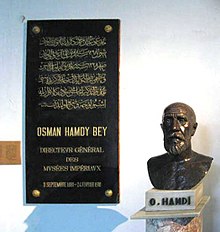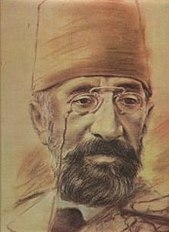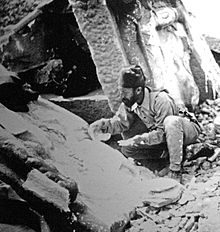Osman Hamdi Bey
Osman Hamdi Bey | |
|---|---|
 Osman Hamdi in 1909 | |
| Born | Osman Hamdi 30 December 1842 Constantinople (Istanbul), Ottoman Empire |
| Died | 24 February 1910 (aged 67) Constantinople, Ottoman Empire |
| Known for | Painter, archaeologist, museographer and writer |
| Notable work | The Tortoise Trainer |
Osman Hamdi Bey (30 December 1842 – 24 February 1910
Early life
Osman Hamdi was the son of

Osman Hamdi went to primary school in the popular Istanbul quarter of Beşiktaş;[7] after which he studied law, first in Istanbul (1856) and then in Paris (1860). However, he decided to pursue his interest in painting instead, left the Law program, and trained under French orientalist painters Jean-Léon Gérôme and Gustave Boulanger.[8] During his nine-year stay in Paris, the international capital of fine arts at the time, he showed a keen interest for the artistic events of his day.[9]
His stay in Paris was also marked by the first ever visit by an
Once back in Turkey, he was sent to the
Career
Osman Hamdi exhibited three paintings at the
In 1882, he instituted and became director of the
He conducted the first scientific based archaeological researches done by a Turkish team. His digs included sites as varied as the
Throughout his professional career as museum and academy director, Osman Hamdi continued to paint in the style of his teachers, Gérôme and Boulanger. Yet, he frequently depicted himself and his family members in these paintings, complicating an assumption of a removed orientalist gaze in his work.[18]
-
Girl Reciting Qur'an (1880)
-
Self-portrait, Osman Hamdi Bey Museum, Gebze
-
Osman Hamdi Bey excavating at the archaeological site in Mount Nemrut
-
Osman Hamdi Bey with his daughter Nazlı. Osman Hamdi Bey Museum, Gebze.
The Tortoise Trainer

Hamdi's 1906 painting,
Modern researchers have identified the animals portrayed are
Historian Edhem Eldem has identified the source of the painting as an engraving of a Korean circus entertainer printed in Le Tour du Monde (1869), a popular French travel magazine.[22] The meaning or any symbolic significance of the tortoises is still contested by scholars.
Work
Osman Hamdi was a prolific painter and author, whose work dealt with themes of archaeology, travel and folk customs in the Middle East.
Hamdi studied painting in Paris under Gustave Boulanger and Jean-Léon Gérôme, two prominent artists in the French Orientalist school. Despite being trained by Gérôme and Boulanger, and his reproduction of European orientalist motifs, Hamdi's paintings present Ottoman subjects differently than his contemporaries' works, most notably giving them more active and intellectual roles. Hamdi's status as an Ottoman intellectual causes many to see his use of orientalist motifs as subversive and critical of European orientalism.[23] During his lifetime, his artwork was displayed more frequently in Europe than in Turkey.[22]
From 1880 on, he exhibited in Paris, Vienna, Berlin, Munich and London, and started a Salon in Constantinople. His works bear witness to a patient and conscientious method, and may be considered as documents of art history. He was the first who dared break with the Turkish pictorial tradition.
Among his works are Prophet's Tomb at Brussa, Miraculous Springs (Paris 1904), Reading the Coran 1890, Theologian (Patrimony of the Austrian Court).
These paintings can be found in private collections and in museums in Vienna, Paris, Liverpool, New York, Berlin and Constantinople (at the Palace of Dolma Bagdsche, at the home of Crown Prince Abdulmedjid).

His painting Reading the Coran has been exhibited at "XI BIENNALE INTERNATIONALE DES ANTIQUAIRES" in Paris in 1982 and at the "FINE ART OF THE NETHERLANDS" at the Waldorf-Astoria in New York in November 1982.
Museums
Berlin "Persian Merchant", Constantinople "Girl reading" and Liverpool "Young Emir studying".
Select list of publications
- Les Costumes Populaires de la Turquie en 1873 (Popular Costumes in Turkey in 1873) by Osman Hamdi Bey, Marie de Launay and photographs by Pascal Sébah, Turkey, Commission Impériale Ottomane pour l'Exposition Universelle de Vienne, 1873.
- Un Ottoman en Orient: Osman Hamdi Bey en Irak, 1869–1871 (An Ottoman in the Orient: Osman Hambdi Bey in Iraq) by Osman Hamdi Bey, Rudolf Lindau, Marie de Launay and Edhem Eldem, c. 1871.
- Une Nécropole Royale à Sidon: Fouilles de Hamdy Bey (A Royal Necropolis in Sidon: Excavations by Hamdy Bey) by Osman Hamdi Bey, Paris, E. Leroux, 1892.
- Le voyage à Nemrud Dağı d'Osman Hamdi Bey et Osgan Efendi (1883): récit de voyage et photographies (The trip to Nemrud Dağı by Osman Hamdi Bey and Osgan Efendi(1883): travelogue and photographs) by Osman Hamdi Bey, Paris, 1883.
- Le Tumulus de Nemrut-Dagi (The Nemrut-Dagi Mound), by Osman Hamdi Bey, Constantinople, F. Lœffler, 1883.
Selected paintings
-
The Tortoise Trainer (1906)
-
Scrivener (1910)
-
Man reading the Quran (1910)
-
Lady Naile (1910)
-
Arms Dealer (1908)
-
Mihrab (1901)
-
Two Young Girls visiting a Türbe (1890)
-
Women in Travel (1887)
-
Women in Front of Mosque (1882)
-
From Harem (1880)
-
A Lady of Constantinople (1881)
-
The Girl Who is Picking Up Lilac (1881)
-
(1879)
-
Reading the Coran (1890)
Paintings at the Pera Museum, Istanbul
-
Kökenoğlu Riza Efendi (1871)
-
Girl with Pink Cap (June 1904)
-
Two Musician Girls (1880)
Paintings at museums outside Turkey
-
Persian carpet dealer on the street (1888), Alte Nationalgalerie, Berlin
Family


- His daughter Nazlı Hamdi (1893–1958)[24] married an Ottoman diplomat, Esat Cemil Bey, in 1912; the couple had one daughter, Cenan Hamdi Sarç, who lived 99 years and died in 2012.[25] Cenan Hamdi married Ömer Celal Sarç, who was the rector of Istanbul University in 1932. She had one son, Faruk Sarç, who was born in 1933. In 1932, Nazlı Hamdi married French engineer, Audoin Fouache d'Halloy (1889–1948).[26]
- He was the brother of Halil Edhem Eldem, who became the Director of the Member of Parliament at the Grand National Assembly of Turkey for ten years under the newly founded Turkish Republic.
- He was the brother of İsmail Galib Bey, considered the founder of numismaticsas a scientific discipline in Turkey.
- He was the granduncle of Sedad Hakkı Eldem, a renowned Turkish architect.
- He was the granduncle of the Turkish Five).
Documentary films
- Osman Hamdi Bey: Kaplumbağa Terbiyecisi ("Osman Hamdi Bey: The Tortoise Trainer") is a 2012 documentary film about the life and works of Osman Hamdi Bey, directed by Umut Hacıfevzioğlu.[27]
See also
References
- ISBN 9780195309911.
- ISBN 978-1-78831-746-7. Retrieved 22 August 2023.
- ISBN 0-520-23335-2.
(Osman Hamdi)…His father, Ibrahim Edhem, was born in the Greek Orthodox village of Sakiz. After being captured as a prisoner of war during a village revolt, he was sold as a slave to the chief naval officer, Kaptan-ı Derya Hüsrev Pasha, the head of the Ottoman Navy, who would also soon serve as vizier to the sultan.
- Chios after the 1822 massacres, he was acquired and brought up by Hüsrev Pasha, who sent him to Paris in 1831 in order to acquire a western education.
- OCLC 10173561.
Edhem Pasha was a Greek by birth, pure and unadulterated, having when an infant been stolen from the island of Chios at the time of the great massacre there
- ^ "Kaplumbağa Terbiyecisi", Osman Hamdi Bey'in Romanı, Emre Can, Kapı Yayınları, 2008, pp 200–201
- ^ The Encyclopædia Britannica, Vol.7, Edited by Hugh Chisholm, (1911), 3; "Constantinople, the capital of the Turkish Empire...".
- ISBN 0-520-23335-2
- ^ Bloom J. and Blair, S., The Grove Encyclopedia of Islamic Art and Architecture, Oxford University Press, 2009 Vol. 3, p.361
- ^ a b W. Shaw, p. 98
- ^ "Kadıköy'ün İlk Şehremini Osman Hamdi Bey Ölümünün 100. Yılında Saygıyla Anıldı" (in Turkish). Archived from the original on 19 February 2015. Retrieved 19 February 2015.
- ^ a b c d "Aşık olduğu iki kadının adı da Marie'ydi...", Posta.com.tr, 11 October 2010.
- ^ Çelik, Zeynep (2016). About Antiquities: Politics of Archaeology in the Ottoman Empire. Austin: University of Texas Press. pp. 62–63.
- )
- ^ "Expedition Magazine | Nippur and Hamdi Bey". penn.museum. Retrieved 19 February 2019.
- ^ W. Shaw, p. 99
- ^ "Le Tumulus de Nemroud-Dagh : voyage, description, inscriptions ... | 1886 - Collections patrimoniales numérisées de Bordeaux Montaigne". 1886.u-bordeaux-montaigne.fr (in French). Retrieved 21 January 2018.
- OCLC 1030061364.)
{{cite book}}: CS1 maint: multiple names: authors list (link - S2CID 57569272.
- ^ Block, Fang (26 September 2019). "'Young Woman Reading' Nets £6.3M, an Auction Record for Osman Hamdi Bey". Barron's.
- ^ Bettelheim, Matthew P. and Ertan Taskavak. 2006. "The Tortoise and the Tulip – Testudo graeca ibera and Osman Hamdi's The Tortoise Trainer". Bibliotheca Herpetologica. 6(2): pp 11–15. The paper is mentioned, and the magazine cover is shown, at ISHBH publication list
- ^ ISSN 0732-2992.
- ISBN 9780822383857
- ^ ""NAZLI'NIN DEFTERİ, OSMAN HAMDİ BEY'İN ÇEVRESİ" SERGİSİ ANAMED'DE AÇILIYOR". aktuelarkeoloji.com.tr. Retrieved 1 December 2015.
- ^ "Kızı Nazlı'nın defterinden Osman Hamdi Bey'in dostları". ZAMAN. 28 April 2014. Archived from the original on 29 April 2014. Retrieved 26 August 2014.
- ^ "Geneanet Ancestry". Geneanet.
- ^ Osman Hamdi Bey: Kaplumbağa Terbiyecisi, Filmeks, 18 April 2012, archived from the original on 19 December 2021, retrieved 18 March 2016
Biography
- Kaplumbağa Terbiyecisi, Osman Hamdi Bey' in Romanı, Emre Can, Kapı Yayınları, 2008.
- L'ammaestratore di Istanbul, Elettra Stamboulis & Gianluca Costantini, Comma 22, 2008.
- L'ammaestratore di Istanbul, Elettra Stamboulis & Gianluca Costantini, Giuda Edizioni, 2013.
- P. & V. BERKO, "Peinture Orientaliste – Orientalist Painting", Knokke-Heist Belgium, 1982.
External links
- The Turtle Tamer of Istanbul Graphic Novel
 Media related to Osman Hamdi Bey at Wikimedia Commons
Media related to Osman Hamdi Bey at Wikimedia Commons


























